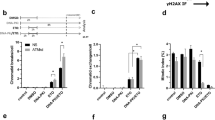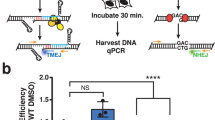Abstract
Purpose
We postulate that the deoxyguanosine analogue CNDAG [9-(2-C-cyano-2-deoxy-1-β-d-arabino-pentofuranosyl)guanine] likely causes a single-strand break after incorporation into DNA, similar to the action of its cytosine congener CNDAC, and that subsequent DNA replication across the unrepaired nick would generate a double-strand break. This study aimed at identifying cellular responses and repair mechanisms for CNDAG prodrugs, 2-amino-9-(2-C-cyano-2-deoxy-1-β-d-arabino-pentofuranosyl)-6-methoxy purine (6-OMe) and 9-(2-C-cyano-2-deoxy-1-β-d-arabino-pentofuranosyl)-2,6-diaminopurine (6-NH2). Each compound is a substrate for adenosine deaminase, the action of which generates CNDAG.
Methods
Growth inhibition assay, clonogenic survival assay, immunoblotting, and cytogenetic analyses (chromosomal aberrations and sister chromatid exchanges) were used to investigate the impact of CNDAG on cell lines.
Results
The 6-NH2 derivative was selectively potent in T cell malignant cell lines. Both prodrugs caused increased phosphorylation of ATM and its downstream substrates Chk1, Chk2, SMC1, NBS1, and H2AX, indicating activation of ATM-dependent DNA damage response pathways. In contrast, there was no increase in phosphorylation of DNA-PKcs, which participates in repair of double-strand breaks by non-homologous end-joining. Deficiency in ATM, RAD51D, XRCC3, BRCA2, and XPF, but not DNA-PK or p53, conferred significant clonogenic sensitivity to CNDAG or the prodrugs. Moreover, hamster cells lacking XPF acquired remarkably more chromosomal aberrations after incubation for two cell cycle times with CNDAG 6-NH2, compared to the wild type. Furthermore, CNDAG 6-NH2 induced greater levels of sister chromatid exchanges in wild-type cells exposed for two cycles than those for one cycle, consistent with increased double-strand breaks after a second S phase.
Conclusion
CNDAG-induced double-strand breaks are repaired mainly through homologous recombination.






Similar content being viewed by others
References
Ewald B, Sampath D, Plunkett W (2008) Nucleoside analogs: molecular mechanisms signaling cell death. Oncogene 27(50):6522–6537. https://doi.org/10.1038/onc.2008.316
Matsuda A, Nakajima Y, Azuma A, Tanaka M, Sasaki T (1991) Nucleosides and nucleotides. 100. 2'-C-cyano-2'-deoxy-1-beta-d-arabinofuranosyl-cytosine (CNDAC): design of a potential mechanism-based DNA-strand-breaking antineoplastic nucleoside. J Med Chem 34(9):2917–2919
Azuma A, Nakajima Y, Nishizono N, Minakawa N, Suzuki M, Hanaoka K, Kobayashi T, Tanaka M, Sasaki T, Matsuda A (1993) Nucleosides and nucleotides. 122. 2'-C-cyano-2'-deoxy-1-beta-d-arabinofuranosylcytosine and its derivatives: a new class of nucleoside with a broad antitumor spectrum. J Med Chem 36(26):4183–4189
Matsuda A (1995) 2'-C-Cyano-2'-deoxy-1-b-d-arabinofuranosyl-cytosine(CNDAC): a mechanism-based DNA-strandbreaking antitumor nucleoside. Nucleosides Nucleotides 14:461–471
Azuma A, Huang P, Matsuda A, Plunkett W (2001) 2'-C-cyano-2'-deoxy-1-beta-d-arabino-pentofuranosylcytosine: a novel anticancer nucleoside analog that causes both DNA strand breaks and G(2) arrest. Mol Pharmacol 59(4):725–731
Liu X, Wang Y, Benaissa S, Matsuda A, Kantarjian H, Estrov Z, Plunkett W (2010) Homologous recombination as a resistance mechanism to replication-induced double-strand breaks caused by the antileukemia agent CNDAC. Blood 116(10):1737–1746. https://doi.org/10.1182/blood-2009-05-220376(blood-2009-05-220376 [pii])
Ohtawa M, Ichikawa S, Teishikata Y, Fujimuro M, Yokosawa H, Matsuda A (2007) 9-(2-C-Cyano-2-deoxy-beta-D-arabino-pentofuranosyl)guanine, a potential antitumor agent against B-lymphoma infected with Kaposi's sarcoma-associated herpesvirus. J Med Chem 50(9):2007–2010. https://doi.org/10.1021/jm070032y
Ichikawa S, Otawa M, Teishikata Y, Yamada K, Fujimuro M, Yokosawa H, Matsuda A (2009) 9-(2-C-Cyano-2-deoxy-beta-d-arabino-pentofuranosyl)guanine, a potential antitumor agent against B-lymphoma infected with Kaposi's sarcoma-associated herpesvirus. Nucleic Acids Symp Ser (Oxf) 53:95–96. https://doi.org/10.1093/nass/nrp048(nrp048 [pii])
Kisor DF (2005) Nelarabine: a nucleoside analog with efficacy in T cell and other leukemias. Ann Pharmacother 39(6):1056–1063. https://doi.org/10.1345/aph.1E453
Gandhi V, Plunkett W (2006) Clofarabine and nelarabine: two new purine nucleoside analogs. Curr Opin Oncol 18(6):584–590. https://doi.org/10.1097/01.cco.0000245326.65152.af
Ziv Y, Bar-Shira A, Pecker I, Russell P, Jorgensen TJ, Tsarfati I, Shiloh Y (1997) Recombinant ATM protein complements the cellular A–T phenotype. Oncogene 15(2):159–167. https://doi.org/10.1038/sj.onc.1201319
Anderson CW, Allalunis-Turner MJ (2000) Human TP53 from the malignant glioma-derived cell lines M059J and M059K has a cancer-associated mutation in exon 8. Radiat Res 154(4):473–476
Anderson CW, Dunn JJ, Freimuth PI, Galloway AM, Allalunis-Turner MJ (2001) Frameshift mutation in PRKDC, the gene for DNA-PKcs, in the DNA repair-defective, human, glioma-derived cell line M059J. Radiat Res 156(1):2–9
Ross GM, Eady JJ, Mithal NP, Bush C, Steel GG, Jeggo PA, McMillan TJ (1995) DNA strand break rejoining defect in xrs-6 is complemented by transfection with the human Ku80 gene. Cancer Res 55(6):1235–1238
Liu X, Guo Y, Li Y, Jiang Y, Chubb S, Azuma A, Huang P, Matsuda A, Hittelman W, Plunkett W (2005) Molecular basis for G2 arrest induced by 2'-C-cyano-2'-deoxy-1-beta-d-arabino-pentofuranosylcytosine and consequences of checkpoint abrogation. Cancer Res 65(15):6874–6881. https://doi.org/10.1158/0008-5472.CAN-05-0288(65/15/6874 [pii])
Wang Y, Liu X, Matsuda A, Plunkett W (2008) Repair of 2'-C-cyano-2'-deoxy-1-beta-D-arabino-pentofuranosylcytosine-induced DNA single-strand breaks by transcription-coupled nucleotide excision repair. Cancer Res 68(10):3881–3889. https://doi.org/10.1158/0008-5472.CAN-07-6885[pii]
Beucher A, Birraux J, Tchouandong L, Barton O, Shibata A, Conrad S, Goodarzi AA, Krempler A, Jeggo PA, Lobrich M (2009) ATM and Artemis promote homologous recombination of radiation-induced DNA double-strand breaks in G2. EMBO J 28(21):3413–3427. https://doi.org/10.1038/emboj.2009.276
Morrison C, Sonoda E, Takao N, Shinohara A, Yamamoto K, Takeda S (2000) The controlling role of ATM in homologous recombinational repair of DNA damage. EMBO J 19(3):463–471
Lees-Miller SP, Godbout R, Chan DW, Weinfeld M, Day RS 3rd, Barron GM, Allalunis-Turner J (1995) Absence of p350 subunit of DNA-activated protein kinase from a radiosensitive human cell line. Science 267(5201):1183–1185
Feldmann E, Schmiemann V, Goedecke W, Reichenberger S, Pfeiffer P (2000) DNA double-strand break repair in cell-free extracts from Ku80-deficient cells: implications for Ku serving as an alignment factor in non-homologous DNA end joining. Nucleic Acids Res 28(13):2585–2596
Thompson LH, Schild D (2001) Homologous recombinational repair of DNA ensures mammalian chromosome stability. Mutat Res 477(1–2):131–153 (S0027510701001154 [pii])
Pierce AJ, Johnson RD, Thompson LH, Jasin M (1999) XRCC3 promotes homology-directed repair of DNA damage in mammalian cells. Genes Dev 13(20):2633–2638
Brown ET, Robinson-Benion C, Holt JT (2008) Radiation enhances caspase 3 cleavage of Rad51 in BRCA2-defective cells. Radiat Res 169(5):595–601. https://doi.org/10.1667/RR1129.1(RR1129 [pii])
Orelli BJ, Bishop DK (2001) BRCA2 and homologous recombination. Breast Cancer Res 3(5):294–298
Wilson DM 3rd, Thompson LH (2007) Molecular mechanisms of sister-chromatid exchange. Mutat Res 616(1–2):11–23. https://doi.org/10.1016/j.mrfmmm.2006.11.017(S0027-5107(06)00317-4 [pii])
Cohen MH, Johnson JR, Justice R, Pazdur R (2008) FDA drug approval summary: nelarabine (Arranon) for the treatment of T cell lymphoblastic leukemia/lymphoma. Oncologist 13(6):709–714. https://doi.org/10.1634/theoncologist.2006-0017
Gandhi V, Keating MJ, Bate G, Kirkpatrick P (2006) Nelarabine. Nat Rev Drug Discov 5(1):17–18. https://doi.org/10.1038/nrd1933
Gandhi V, Mineishi S, Huang P, Yang Y, Chubb S, Chapman AJ, Nowak BJ, Hertel LW, Plunkett W (1995) Difluorodeoxyguanosine: cytotoxicity, metabolism, and actions on DNA synthesis in human leukemia cells. Semin Oncol 22(4 Suppl 11):61–67
Shewach DS, Daddona PE, Ashcraft E, Mitchell BS (1985) Metabolism and selective cytotoxicity of 9-beta-d-arabinofuranosylguanine in human lymphoblasts. Cancer Res 45(3):1008–1014
Shewach DS, Mitchell BS (1989) Differential metabolism of 9-beta-d-arabinofuranosylguanine in human leukemic cells. Cancer Res 49(23):6498–6502
Gumy-Pause F, Wacker P, Sappino AP (2004) ATM gene and lymphoid malignancies. Leukemia 18(2):238–242. https://doi.org/10.1038/sj.leu.2403221
Liberzon E, Avigad S, Yaniv I, Stark B, Avrahami G, Goshen Y, Zaizov R (2004) Molecular variants of the ATM gene in Hodgkin's disease in children. Br J Cancer 90(2):522–525. https://doi.org/10.1038/sj.bjc.6601522
Takeuchi S, Koike M, Park S, Seriu T, Bartram CR, Taub HE, Williamson IK, Grewal J, Taguchi H, Koeffler HP (1998) The ATM gene and susceptibility to childhood T cell acute lymphoblastic leukaemia. Br J Haematol 103(2):536–538
Sakashita A, Hattori T, Miller CW, Suzushima H, Asou N, Takatsuki K, Koeffler HP (1992) Mutations of the p53 gene in adult T cell leukemia. Blood 79(2):477–480
Staub M, Eriksson S (2006) The role of deoxycytidine kinase in DNA synthesis and nucleoside analog activation. Chapter 2:29–52
Sabini E, Ort S, Monnerjahn C, Konrad M, Lavie A (2003) Structure of human dCK suggests strategies to improve anticancer and antiviral therapy. Nat Struct Biol 10(7):513–519. https://doi.org/10.1038/nsb942
Wang J, Choudhury D, Chattopadhyaya J, Eriksson S (1999) Stereoisomeric selectivity of human deoxyribonucleoside kinases. Biochemistry 38(51):16993–16999. https://doi.org/10.1021/bi9908843
Zhu C, Johansson M, Permert J, Karlsson A (1998) Phosphorylation of anticancer nucleoside analogs by human mitochondrial deoxyguanosine kinase. Biochem Pharmacol 56(8):1035–1040. https://doi.org/10.1016/s0006-2952(98)00150-6
Zhu C, Johansson M, Permert J, Karlsson A (1998) Enhanced cytotoxicity of nucleoside analogs by overexpression of mitochondrial deoxyguanosine kinase in cancer cell lines. J Biol Chem 273(24):14707–14711. https://doi.org/10.1074/jbc.273.24.14707
Rodriguez CO Jr, Stellrecht CM, Gandhi V (2003) Mechanisms for T cell selective cytotoxicity of arabinosylguanine. Blood 102(5):1842–1848. https://doi.org/10.1182/blood-2003-01-0317(2003-01-0317 [pii])
Liu X, Jiang Y, Nowak B, Hargis S, Plunkett W (2016) Mechanism-based drug combinations with the DNA strand-breaking nucleoside analog CNDAC. Mol Cancer Ther 15(10):2302–2313. https://doi.org/10.1158/1535-7163.MCT-15-0801
Liu X, Jiang Y, Nowak B, Qiang B, Cheng N, Chen Y, Plunkett W (2018) Targeting BRCA1/2 deficient ovarian cancer with CNDAC-based drug combinations. Cancer Chemother Pharmacol 81(2):255–267. https://doi.org/10.1007/s00280-017-3483-6
Acknowledgements
The authors are grateful to Drs. Asha Multani and Jin Ma (T. C. Hsu Molecular Cytogenetics Core at MDACC) for their technical support in cytogenetic studies (SCE).
Funding
This work was supported in part by grants R01 CA28596 (W. Plunkett), P50 CA100632 (W. Plunkett), and Cancer Center Support Grant P30 CA16672 from the National Cancer Institute, Department of Health and Human Services.
Author information
Authors and Affiliations
Contributions
XL and WP: conception and design. XL and YJ: development of methodology. XL, YJ, BN, SI, MO, and AM: acquisition of data (provided animals, acquired and managed patients, provided facilities, etc.). XL, YJ, and WP: analysis and interpretation of data (e.g., statistical analysis, biostatistics, and computational analysis). XL, YJ, and WP: writing, review, and/or revision of the manuscript. XL, YJ, and BN: administrative, technical, or material support (i.e., reporting or organizing data, and constructing databases). WP: study supervision.
Corresponding author
Ethics declarations
Conflict of interest
The authors declare that they have no conflict of interest.
Ethical approval
This article does not contain any studies with human participants or animals performed by any of the authors.
Additional information
Publisher's Note
Springer Nature remains neutral with regard to jurisdictional claims in published maps and institutional affiliations.
Electronic supplementary material
Below is the link to the electronic supplementary material.
280_2020_4035_MOESM1_ESM.jpg
Supplemental Figure 1. Chromosomal aberrations induced by CNDAG 6-NH2. Representative images of mitotic spreads of AA8 and UV41 cells untreated and treated with 8 µM CNDAG 6-NH2 for 15 hours and 30 hours, respectively. Arrows indicate chromosomal breaks or gaps
280_2020_4035_MOESM2_ESM.jpg
Supplemental Figure 2. Cell cycle progression of CCRF-CEM cells after treatment with CNDAC or CNDAG derivatives. Suspension cells were exposed to 0.5 μM CNDAC, 50 μM CNDAG 6-OMe, and 50 μM CNDAG 6- NH2, respectively, for 24 hr. Cells were harvested, fixed and subjected to analysis by flow cytometry. (A) DNA content profiles are presented for all samples. (B) A stacked-bar plot is shown to present the percentage of all cell cycle phases in the whole populations
280_2020_4035_MOESM3_ESM.jpg
Supplemental Figure 3. Lack of p53 does not sensitize HCT116 cells to CNDAG. HCT116 cells with wild-type p53 (■) and p53 knocked-out (o) were washed into drugfree medium after a 24-hour exposure to CNDAG 6-NH2 at a range of concentrations and allowed to form colonies in 7–8 days. All points, mean ± SD of triplicate plates
280_2020_4035_MOESM4_ESM.jpg
Supplemental Figure 4. Sister chromatid exchanges in AA8 cells treated with mitomycin C (MMC). A representative image of metaphase chromosome spreads is shown.
280_2020_4035_MOESM5_ESM.jpg
Supplemental Figure 5. Proposed model for roles of DNA repair proteins in cellular response to CNDAG. CNDAG prodrugs are metabolized into the active form CNDAG under the action of adenosine deaminase (ADA). Deoxycytidine kinase (dCK) and deoxyguanosine kinase (dGK) are responsible for phosphorylating CNDAG. CNDAG triphosphates are incorporated into DNA and subsequently induce SSBs through β-elimination during the first S phase. The transcription-coupled nucleotide excision repair pathway (TC-NER) recognizes SSBs and contributes to cell survival (Wang, Liu, Matsuda, and Plunkett, 2008). Unrepaired SSBs are converted into DSBs mainly by replication in the second S phase. DSBs are lethal if left unrepaired. The homologous recombination (HR) pathway, which is activated by ATM, and involves RAD51, XRCC3 and BRCA2, is a major contributor to this survival function. The non-homologous end-joining (NHEJ) pathway is dispensable for cell survival of CNDAC-induced damage.
Rights and permissions
About this article
Cite this article
Liu, X., Jiang, Y., Nowak, B. et al. Repair of DNA damage induced by the novel nucleoside analogue CNDAG through homologous recombination. Cancer Chemother Pharmacol 85, 661–672 (2020). https://doi.org/10.1007/s00280-020-04035-x
Received:
Accepted:
Published:
Issue Date:
DOI: https://doi.org/10.1007/s00280-020-04035-x




